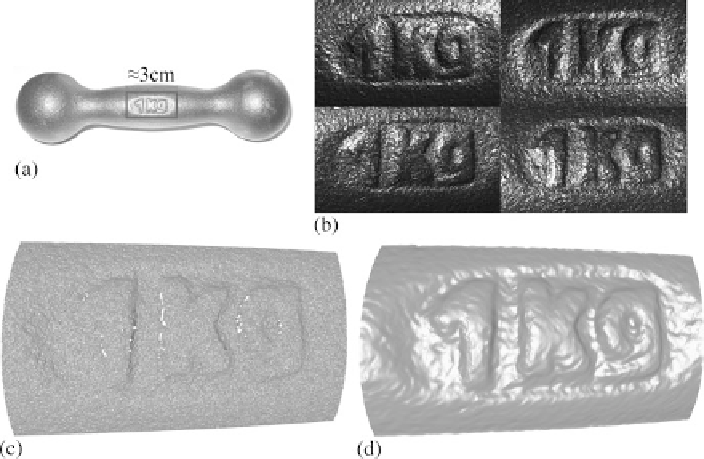Graphics Reference
In-Depth Information
Fig. 6.32
Three-dimensional reconstruction results of an embossing on a dark, rough cast iron
surface. Image credit: S. Herbort. (
a
) Dumbbell-shaped object. The reconstructed surface part is
marked. (
b
) Four images from the set of twelve images acquired under different illumination con-
ditions. (
c
) Shaded view of the depth data determined based on projection of structured light. The
white areas
denote gaps in the data. (
d
) Shaded view of the three-dimensional reconstruction result
obtained with the combined method described in Sect.
5.5
The three-dimensional reconstruction result obtained with the combined method
has a high lateral resolution and reveals both the shape of the surface on large spa-
tial scales and most small-scale surface details visible in the acquired images (cf.
Fig.
6.32
d). The height of the embossing has been determined to 0
.
67
0
.
02 mm
by tactile measurement with a caliper gauge. The combined three-dimensional re-
construction method yields a consistent height value of 0
.
69 mm.
±
6.3.6 Discussion
It has been shown in Sect.
6.3.1
that the image-based approach suggested by Wöh-
ler and Hafezi (
2005
) can be used for three-dimensional surface reconstruction in
the context of industrial quality inspection. The shadow information provides depth
information on large spatial scales, while fine surface details are revealed by the
shading information.
The combined framework for three-dimensional surface reconstruction based on
photopolarimetric information and independently measured depth data proposed by
d'Angelo and Wöhler (
2008
) can be favourably used in the application scenario of
industrial quality inspection (cf. Sect.
6.3.3
). The accuracy of depth differences on

Search WWH ::

Custom Search